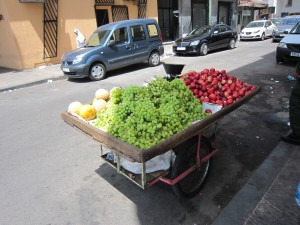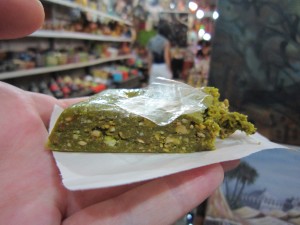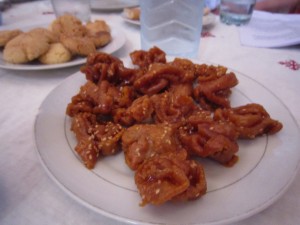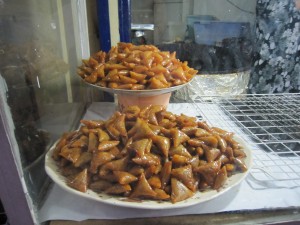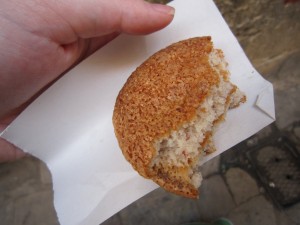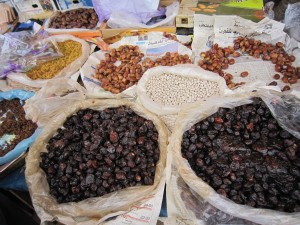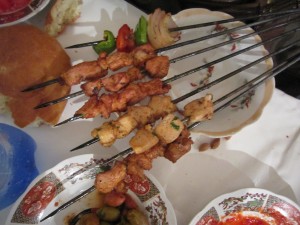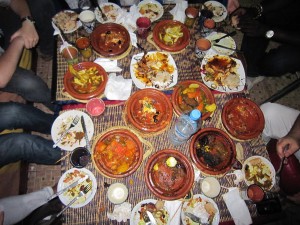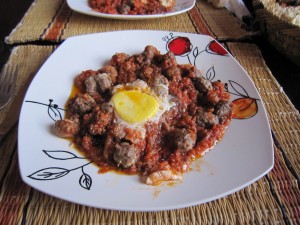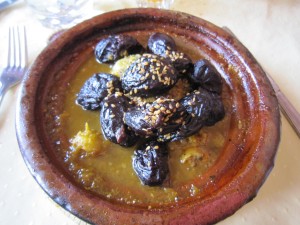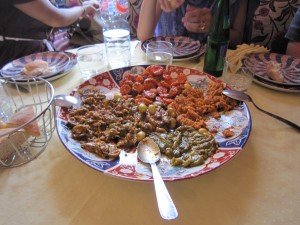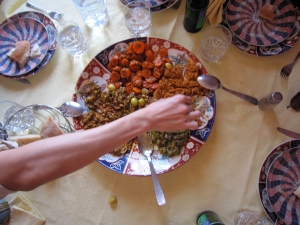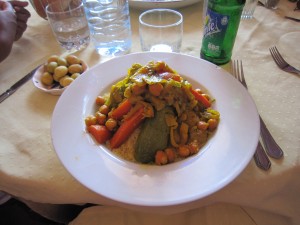I have just over a week left in Morocco, and I feel like I’ve run the gamut of restaurant types. I’ve eaten everywhere from a stand in the middle of a crazy, smoky square in Marrakesh to restaurants in opulent old houses that suddenly appears at the end of a dark alley in the medina of Fez. I’ve also
eaten at all the in between places—restaurants in gas stations, which is apparently a big thing, and the little places scattered across the town I’m in. I’ve found that my most memorable meals have come at the extremes of the spectrum. Donuts fried in front of you at a sweet stand, sprinkled with sugar and eaten standing up in a split second. Tables groaning under plate upon plate of different vegetables, and that’s just the first course. The stuff in between tends to blend together into one big tagine. That’s not to say that you can’t get great food at the mid-range restaurants, it’s just harder to tell if the lemon chicken tagine is going to be sublime or just mediocre.
Let’s start with the cheap stuff. We’ve walked through a whole bunch of medinas (the old section of Moroccan cities) at this point, and every time we pass a food stall (usually either dried fruits or sweets), I crane my neck and sometimes succumb to the temptation to dig in. In Marrakesh there were carts everywhere selling different kinds of nut paste/nougat thing. I got some pistachio, which was delicious—very sweet, I think sweetened with honey, but the pistachio flavor shined. In all the medinas you’ll also find pyramids of honey-soaked sweets, often covered in flies and bees. The most ridiculously indulgent (in the best way possible) are the chebakia, made from dough that is deep fried and then doused in honey and orange blossom water. Also delicious are little envelopes of pastry, coated in honey, filled with almond or peanut
paste. And while we’re on the topic of peanuts, one of my friends bought what she described as a “Moroccan whoopee pie” from a vendor in the Fez medina. It was two puffy almond-meal cakes sandwiched around a peanut butter filling—utterly delicious, and an excellent breakfast. Freshly squeezed orange juice also abounds in markets, but I was drawn instead to the tea stalls in Jma al Fna in Marrakesh. Instead of the ubiquitous Moroccan mint tea, this was a heavily spiced cinnamon—I had to buy some, it was so delicious. Everything you want American chai to be.
And I almost forgot all the fruit! Watermelon cut off the “tasting melon” at a souk and given to us for free with the toast “to your health.” Piles of dried dates and figs in every market you come across. Being forced to eat prickly pear after prickly pear from a cart before finally convincing the owner that we actually want to buy some to go. I may be lacking for fruit on campus, but there’s certainly tons to be found on the streets.
But on to the real food. We had dinner one night in Jma al Fna, the square in Marrakesh that turns into a crazy, smoke-filled riot of the senses at night. Food stalls crop up out of nowhere starting around five o’clock. Our group of ten sat down at one and I think just ordered everything on the menu… the food just kept coming, long after we had eaten our fill. It seemed pretty typical street
food—lots of skewers of meat, though the spicy red sauce we requested was an excellent accompaniment, and one of the few actually spicy things I’ve encountered in Morocco. The price tag, however, was close to those at upscale restaurants outside Marrakesh, a sad sign that Jma al Fna is more a tourist than local attraction at this point. Cheap food does abound, however. At a souk in Azrou a couple days later I finally tried a merguez sausage sandwich for about a buck—though tasty, I found the flavor a little too distinctive for my taste. Distinctive of what, I could not tell you… perhaps too lamb-y, it just wasn’t my favorite. The brochette (kebab) at the same stall were extremely fatty, salty, and delicious, however. I’m going to have to stop here because I am off tomorrow morning on my next culinary adventure, to an oasis in the Sahara. Who knows what they eat out there! So you will have to hold on just a little longer for tales of opulent lunches that left us practically comatose.
